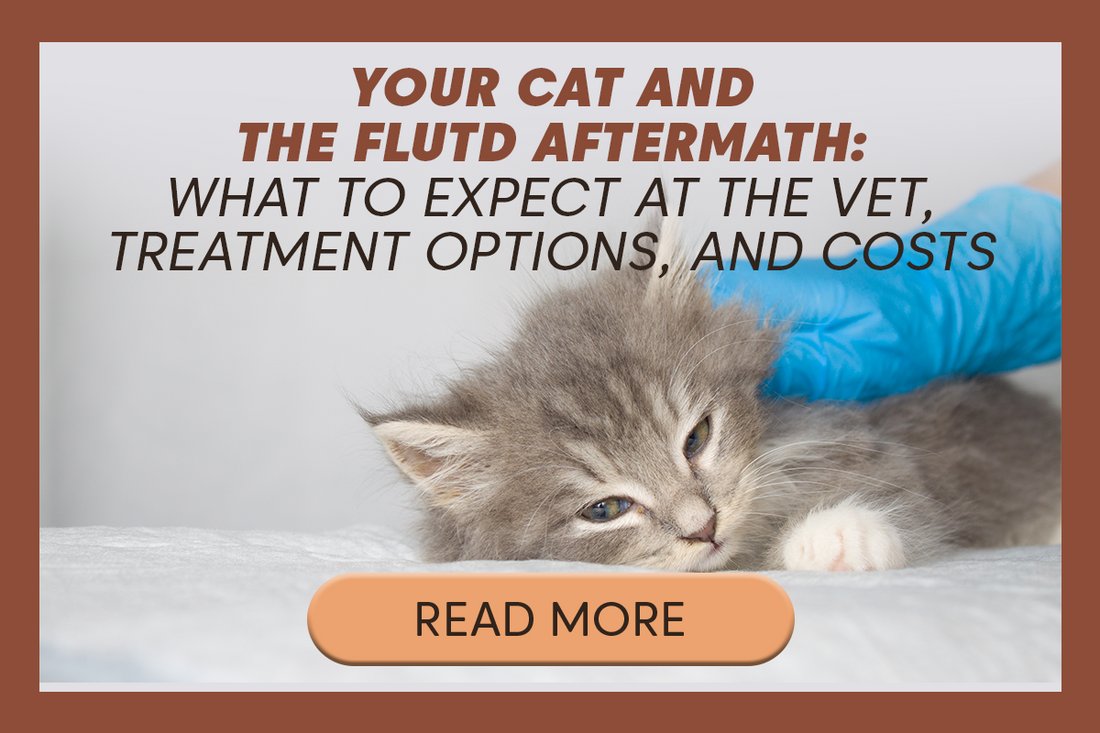
What to Expect at the Vet, Treatment Options, and Costs
Share
Your Cat and the FLUTD Aftermath: What to Expect at the Vet, Treatment Options, and Costs
by Lysette Anne Almazar, DVM
Imagine following a trail of blood-tinged drops leading to your cat’s litter box. He’s been there several times already, and each visit seems to take longer than the last. You finally check the litter—and despite all that time spent, there’s nothing to scoop. It’s empty.
Have you ever seen a scene like this with your own pet? You might have. And before you know it, you and your cat are sitting in the vet’s office, trying to make sense of a whirlwind explanation about Feline Lower Urinary Tract Disease (FLUTD).
(For more on FLUTD basics, please refer to our other published articles.)
Sounds like a horror scene, right? Unfortunately, it’s a reality for many cats with FLUTD. Here are more red flags to keep on your radar:
- Vocalizing or crying during urination
- Prolonged stay at the litterbox
- Dribbling urine
- Distended abdomen or palpable urinary bladder
- Overgrooming of the abdominal area
- Licking of the genitals
- Inappetence
- Lethargy
If you checked off more than two symptoms above and you’re suspecting your pet has FLUTD, it’s probably time for your pet to visit the vet. At the clinic, your veterinarian may recommend a range of laboratory tests, such as a complete blood count (CBC), blood chemistry panel, X-rays, ultrasound, and/or urinalysis.
These tests are recommended at the discretion of your attending vet, based on your pet’s history and physical exam findings. Prices for these tests typically range from Php 800 to Php 4,000.
Each test plays a unique role in helping to come up with the correct diagnosis, which is key to formulating the right treatment plan. While some tests may seem similar, they serve different purposes. For instance, both X-rays and ultrasounds are imaging tests, but X-rays are better at visualizing denser structures like bladder stones (cystoliths), whereas ultrasounds can provide more detail about the bladder wall and soft tissues.
In reality, budget is always a factor in deciding whether or not to pursue these diagnostics. Be open with your vet about your concerns. Good communication and a strong relationship between pet parent and veterinarian are crucial for your pet’s successful treatment.
Some pet owners are discouraged from visiting the vet due to financial constraints. However, the longer you delay treatment, the worse the condition may become—and the higher the vet bills could go. Early intervention is key. Fewer complications mean fewer medications and lower costs overall.
Depending on the underlying cause of FLUTD (e.g., UTI, idiopathic cystitis, etc.), treatment may include antibiotics, urinary acidifiers, adjunct therapies, prescription diets, catheterization, and hospitalization. Keep in mind, not all cases of FLUTD require antibiotics. Your vet will create a tailored treatment plan based on diagnostic results. In more severe cases, surgery may be necessary.
For the costs, catheterization alone may range anywhere from Php 2,500 to Php 5,000. Hospitalization accounts for a significant portion of the cost, as your pet may require overnight monitoring, IV fluids, injectable medications, and even an ICU cage. A night at an emergency clinic may cost Php 1,500 or more.
Diagnosing and treating FLUTD can be a significant financial burden for pet owners. But as I always say, educated pet owners make the best decisions for their pets. The best education we can offer starts with prevention: minimize stress, promote a healthy lifestyle (mental stimulation, access to clean resources), provide balanced nutrition and adequate hydration, and schedule regular vet checkups.
FLUTD can be daunting, intimidating and discouraging. It’s a real-life monster for your pet cat. But it doesn’t always have to be that way. As pet parents and veterinarians, we can change the story because every cat deserves a happy ending.
